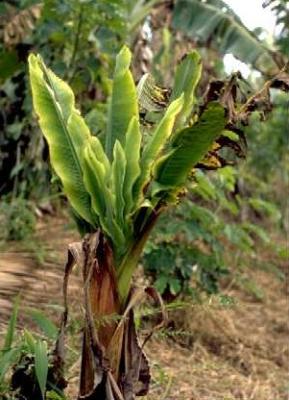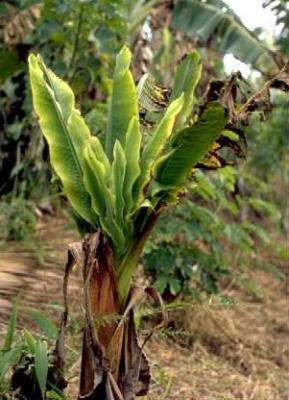


Bunchy top disease
It is a virus disease transmitted by aphids (for more information on aphids click here. The typical symptoms of bunchy top of banana are very distinctive and readily distinguished from those caused by other viruses of banana. Plants can become infected at any stage of growth and there are some initial differences between the symptoms produced in aphid-infected plants and those grown from infected planting material.
In aphid-infected plants, a few dark-green streaks or dots usually appear on the minor veins and the midrib of the second leaf to emerge after inoculation. They are best seen from the underside of the leaf in transmitted light. The 'dot-dash' symptoms can sometimes also be seen on the petiole. The following leaf may display whitish streaks along the secondary veins when it is still rolled. These streaks become dark green as the leaf unfurls. Successive leaves become smaller, both in length and in width of the lamina, and often have chlorotic, upturned margins. The leaves become dry and brittle and stand more erect than normal giving the plant a rosetted 'bunchy top' appearance.
Suckers from an infected stool can show severe symptoms in the first leaf to emerge. The leaves are rosetted and small with very chlorotic margins that tend to turn necrotic. Dark-green streaks are usually evident in the leaves.
Infected plants rarely produce a fruit bunch after infection and do not fruit in subsequent years. Plants infected late in the growing cycle may fruit once, but the bunch stalk and the fruit will be small and distorted. On plants infected very late, the only symptoms present may be a few dark green streaks on the tips of the flower bracts.
- Eradicate diseased plants. The whole stool, including rhizome/corm and all associated suckers, must be destroyed by uprooting and chopping into small pieces, as the virus can ultimately spread to all parts of the mat. Control must be practiced across the whole production area to avoid the rapid re-infection.
- Use of virus-free planting material
